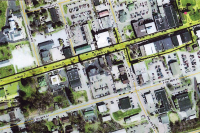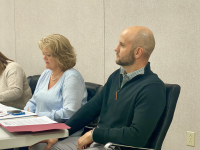Landslide protocol: a muddied affair
 The tragic death of a railroad worker investigating a fresh landslide along a rail line last week highlighted the hidden, yet inherent, risks for workers who are first on the scene in the aftermath of a slide.
The tragic death of a railroad worker investigating a fresh landslide along a rail line last week highlighted the hidden, yet inherent, risks for workers who are first on the scene in the aftermath of a slide.
Joseph Drewnoski, 33, of Waynesville, was buried and killed by a landslide in the middle of the night while surveying tracks for storm damage near Black Mountain following a weekend of unrelenting rains. Norfolk Southern Railway got a report of a landslide on the tracks in the middle of the night and sent Drewnoski and another worker to check it out.
Drewnoski headed down the line in a specialized rail-running truck. It was about 2 a.m. and still raining when Drewnoski arrived at the slide. He got out of the truck to take a better look when the landslide tumbled some more. His co-worker was still in the truck, which was thrown from the track by the slide, but Drewnoski was buried.
The fatal incident has sparked an investigation by Norfolk Southern as well as the Federal Railroad Administration, which is standard policy when a railroad worker is killed.
The agency would not release any information about the ongoing investigation but will make the results public when it is finished. That could be anywhere from a few months to a year, according to Mike England, a spokesperson with the Federal Railroad Administration.
Related Items
Inspecting tracks was part of Drewnoski’s job, including checking out slide reports, according to Robin Chapman, a spokesperson for the railroad.
Chapman would not elaborate on the railroad’s policies for handling slides or whether those were followed, citing that as part of the ongoing investigation.
“Suffice it to say there are protocols,” Chapman said. “Our engineering department is prepared for all eventualities and one of those is a mudslide or landslide, and they would have procedures for responding to those.”
Landslides have become a more common occurrence in the mountains in recent years. But there is not a cohesive or consistent response plan followed by the region as a whole, nor a singular training protocol to guide workers who find themselves on the front lines.
SEE ALSO: Will Holder Branch hold? Double landslides make residents uneasy
“Anytime you are around unstable ground it is tricky, particularly when it is still rainy or it is dark,” said Rick Wooten, a landslide expert with the N.C. Geological Service based in Asheville. “Landslides are predictably unpredictable. It is good to be very cautious at the beginning until you get a feel for what kind of landslide it is. It is very difficult to do if you can’t see it.”
When there’s a major slide, Wooten is the go-to expert in the region to assess whether the ground is stable or still at risk of sliding more. He approaches any fresh slide with caution.
“You look at it and think, ‘If it fails, it is going to come this direction so you approach it from the side or the top,” Wooten said.
Before actually lacing up his boots, he consults terrain maps and soil data to get an idea of what to expect. Once on site, he looks for telltale signs that the slide could still be active.
“You get an idea for how the whole hillside is working. Are there cracks in the ground? Are things still really wet? How steep are they? Are they nearly vertical?” Wooten said.
But even as a geotechnical expert, it’s not a perfect science.
“There is still a lot of guesswork involved. You hope you are seeing the things you need to see and make the right call,” Wooten said.
In the aftermath of a landslide, emergency responders have to check their natural instincts to rush toward the source of danger.
“We don’t just drive up the road with the rocks tumbling around us. That’s how you get first responders hurt. We treat it more like a hazmat,” said Greg Shuping, emergency services director in Haywood County. “Instead of rushing into a burning building like you would on a fire or a cardiac arrest, we put our heads together and put together a plan. We will not jeopardize our own safety in lieu of using an organized approach.”
Stop, watch and listen
When it comes to landslide response, Haywood County likely has the most finely tuned and well-honed protocols — partly because Haywood is the landslide leader in region, witnessing more of them in recent years than any other county. But that wasn’t always the case.
“When we first started having landslide issues several years ago, I said, ‘Wow we don’t have a plan for this,’” recalled Shuping.
Thus, Shuping set out to fix that.
“When I am making a new plan, the first thing I try to do is plagiarize from another community. The smart thing to do is not to reinvent the wheel but to take what other communities have,” Shuping said.
But Shuping discovered no one else had one either.
“We couldn’t find a local example of landslide response that I could steal from to get good ideas,” Shuping said.
Instead, he turned to slide prone areas out West in California and Oregon.
“A lot of our experience at the beginning came from the other side of the country,” Shuping said. “We stayed on the phone for hours with them talking about this.”
Shuping discovered Haywood County had a secret weapon when it came to landslides. He enlisted the county’s soil and erosion inspector Marc Pruett as an honorary emergency responder. When there’s a landslide, Pruett gets dispatched right along with Shuping.
“The 911 center calls Marc just like he was a firefighter,” Shuping said.
In the years since, Shuping and Pruett have spent many a day — and night — wading through ankle-deep mud in their rain slickers to size up slide sites together. Shuping said many counties don’t have their own in-house soil and erosion specialists.
“We at least have a front-line person who has some expertise beyond that of an emergency responder,” Shuping said.
Most slides originate from road banks or excavated slopes that posed trouble in the past.
“Before we even get there, Marc is calling me saying, ‘Oh yeah, I know that road, or I remember that spot.’”
Wooten said Haywood County has one of the best protocols for landslide response.
“They know if it is dark to do what they need to do to get people out and then wait until morning to go take a look at it. Don’t take any more risk than absolutely necessary,” Wooten said.
Still, someone has to be the first one in, the first one to lay eyes on a landslide.
“It is hard to write a manual where someone can look it up and say, ‘OK, we are alright.’ It is always going to fall back to a judgment call. Even if you have a policy, you have to interpret the policy,” said Joel Setzer, the head of the N.C. Department of Transportation’s 10-county mountain region.
Since many landslides involve roads, DOT road maintenance crews regularly find themselves in that frontline role.
Setzer said he was very saddened to hear about the landslide that claimed the life of the railroad worker.
“That hit close to home for us. I thought about some of the work we do out at night,” Setzer said. “How do we respond to protect the citizens and at the same time protect the people responding? How do you know if it is going to slide again? Anytime someone is hurt or injured on the job it is certainly a good question to ask or look into it.”
The DOT has in-house geologists who assess major slides.
“If there is one where we aren’t sure how it is going to behave, we want geologists’ opinion,” Setzer said.
By virtue of working in the mountains, however, slides go with the territory. So road maintenance crews have acquired institutional knowledge of what signs to look for, Setzer said.
Workers know to listen as well as look. The sound of rushing water in cracks is no good, and just before a rock slide, you can sometimes hear popping or cracking, Setzer said.
Landslides aren’t the only hazard road crews contend with, however. From flooding to ice storms, road maintenance crews are often out battling the elements to clear fallen trees or put up road blocks around washed out bridges.
Setzer recalls the infamous blizzard of 1993, when road crews working to salt and plow the roads ran the danger of wrecking themselves, prompting questions over when they should just throw in the towel in the name of their own safety, Setzer recalled.
When it rains, it pours
Unfortunately, landslides come in rashes. When heavy rains drag on, soils reach a saturation tipping point and slides start coming down. There can be a few dozen landslides in a few hours across the mountains.
When there are lots of landslides, DOT workers often act like smokejumpers, moving from one to the next and triaging which are most critical, Setzer said.
It can be taxing for the handful of landslide experts to them quickly to render expert opinions. The state once had a team of seven landslide experts housed in the Asheville office of N.C. Department of Environment and Natural Resources. Their day job was creating landslide hazard maps for each county in the mountains. When actual landslides hit, they could quickly mobilize to boots on the ground to help emergency responders size up fresh slides.
But the landslide mapping project was axed by the state legislature two years ago, and most of the landslide team was laid off before they could complete the landslide risk database. Now, there are only two geologists besides Wooten.
The chain of command for landslide response usually starts with a 911 call. If deemed an emergency, a local dispatcher will call it in to the state emergency operations center — a standard protocol anytime a county needs to marshal extra disaster assistance, whether it’s a flood, tornado, forest fire or what have you.
If it’s a landslide emergency, the state contacts the head of the state geological service, who in turn would call Wooten. But in reality, county emergency management directors probably have already called Wooten directly.
Norfolk Southern isn’t a stranger to landslides on the track. Building railroad tracks through the mountains meant cutting into the hillsides, often leaving steep banks above or below the tracks and thus candidates for slides.
“It is not unusual when you have heavy rains. It is something that can happen and does occasionally. We are certainly alert to the possibility,” Chapman said.
While an occasional slide happens on completely virgin ground, the vast majority originate on mountainsides that have been dug into. Excavating makes slopes less stable, setting the stage for a slide.
“It takes less water to push that over the brink,” Wooten said.
Rain is often blamed as the cause of landslides, but there’s an important nuance.
“The rain triggers it. I would argue that is not the cause. The rain knocks down the dominoes, but it didn’t set them up,” Wooten said.
In the Pacific Northwest, one railroad outside Seattle has seen 200 landslides hit its tracks this season alone — a frequency that easily makes it the leading expert on landslides in the rail world, albeit the title isn’t exactly worn with pride.
Most of them don’t start on railroad property, but instead come from uphill slopes where construction altered the terrain.
“We are caught on the other side with a shovel,” said Gus Melonas, spokesperson for BNSF railway.
Most of the slides are what Melonas called “nuisance slides.” It’s just a matter of clearing a pile of mud, trees and rocks. But 85 slides actually landed on tracks. When that happens, BNSF shuts down passenger service on that section of the line for 48 hours to ensure the threat of slides has abated. But workers don’t get that same pass. The railroad doesn’t have the luxury to wait until daylight or when it stops raining to start clearing the tracks.
On more significant slides, the railroad calls in geotechnical consultants.
But given the frequency, the railroad’s track inspectors and engineers are versed in sizing up and responding to landslides.
“It is so routine, it is part of the work process,” Melonas said. “They work in these conditions regularly. They are trained for safety and recognize the lay of the land.”









